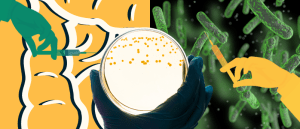Gold nanoframework shows promise in cancer drug delivery

A drug delivery framework made with gold nanoparticles targets tumors with high precision.
At around £50 per gram, gold is the third most valuable metal in the world and has been widely used in magnificent and extravagant jewelry for thousands of years. Now, this precious metal is getting a makeover and shows promise in delivering cancer therapeutics to tumors with high precision whilst reducing the potential of harmful side effects.
A collaboration of researchers at the Stevens Institute of Technology and Hackensack Meridian Health (both NJ, USA) have created a porous gold nanoframeworks and sealed IT848, a small molecule with anti-lymphoma and anti-myeloma properties, inside using a hyaluronic coating. This resulted in a stable particle that releases its therapeutic cargo only when it binds to hyaluronic acid receptors that are located on the surface of a lymphoma tumor.
“Gold is very stable, so it’s the perfect material for drug delivery,” explained Hongjun Wan (Stevens Institute of Technology), co-corresponding author of the recent paper describing the development of this delivery system.
This was tested in vitro with myeloma and lymphoma cell lines and in vivo with animal studies, which demonstrated that the gold nanoparticle framework delivers its payload with minimal leakage into the bloodstream. Utilizing traditional delivery methods, detectable toxicity is observed in around 50% of subjects. This allows a lower drug dose to be administered, reducing the risk of potential side effects.
 Bacteria provide inspiration for novel therapeutic delivery approaches
Bacteria provide inspiration for novel therapeutic delivery approaches
Researchers have taken inspiration from natural injection-like systems in bacteria to develop novel drug delivery approaches.
Overall, the in vivo and in vitro studies showed no signs of toxicity, an improved safety profile and enhanced efficacy with minimal dosing, indicating the potential of this drug delivery system.
Additionally, gold nanoparticles will continue circulating in the bloodstream for longer than a free-floating drug molecule, which could offer the possibility of weekly or biweekly treatment regimens for patients who currently require daily treatments.
The researchers believe that the inexpensive and scalable chemical processes required to load the frameworks with their therapeutic cargo will offset the price of gold as Wang commented, “cost is always a concern, of course, but this is a simple methodology, and we think the benefits speak for themselves.”
These tumor-targeting gold nanoparticle frameworks could be utilized in other clinical applications, for example, as contrast agents to precisely image tumors. Additionally, shining a light on tumors that have been targeted with the gold nanoparticles could “cook” the tumors from within, or the particles could be triggered to deliver their cargo with light.
The FDA has previously approved the use of gold in other clinical applications, so the researchers hope to trial their drug delivery system in cancer patients in the near future. They also plan to develop outer pore sealants that target antibodies as well as other harder-to-treat tumors with high specificity.
“Our ultimate goal is to use this approach to target multiple myeloma and other cancers that are currently not curable,” concluded Wang. “I hope we can complete the foundational research and push this forward to clinical trials soon.”